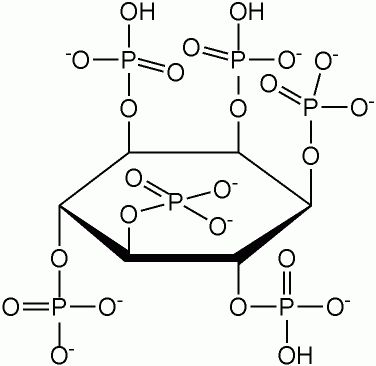Phytic acid is becoming a hot topic on the internet, even Lance Armstrongs website is talking about it.
In all my reading, this explanation seemed the easiest to understand (aside from all the scientific terms)
Phytic acid (known as inositol hexaphosphate (IP6), or phytate) is the principal storage form of phosphorus in many plant tissues, especially in the grass family (wheat, rice, rye, barley etc) and beans. Phosphorus in this form is generally not bioavailable to humans because humans lack the digestive enzyme, phytase, required to separate phosphorus from the phytate molecule.
 Phytate structure (Source)
Phytate structure (Source)
Phytic acid binds to important minerals such as calcium, magnesium, iron and zinc and can therefore contribute to mineral deficiencies, as the minerals are not released from the phytate and are thus unavailable to the body. For people with a particularly low intake of essential minerals, especially young children and those in developing countries, this effect can be undesirable.
A common way in developing countries to increase the bioavailability of minerals from grains and beans is using fermentation. Many bacteria possess phytase activity and by fermenting grains or beans by lactic acid bacteria the phytate is destroyed and the bioavailability of the minerals is increased.
Phytic acid recently has been studied for its potential anti-carcinogenic properties. Recent studies have indicated that phytic acid may have some preventive effect in prostate, breast, pancreatic and colon cancer. The mechanism, however, is not yet understood.
If we can reduce the phytic acid in whole grains, our bodies can better absorb the minerals and the food is easier assimilated into our bodies. Here is an easy recipe for whole wheat pancakes, using the soaking method. It yeilds a light and fluffy pancake. Skip any boxed whole grain pancake mixes and give this a try, its easy and tasty too!
Whole Wheat Pancakes
3 cups fresh ground wheat flour
2 1/2 - 3 cups kefir
1/3 honey
2 T. baking powder
1 tsp salt
1/2 cup powdered milk
1/3 cup coconut oil
2 eggs
About 24 hours before you plan to make your pancakes, combine wheat and kefir in a large bowl.
It does not need to be runny, just be sure to use enough kefir to moisten your wheat, like this:
 Stir it up really good and cover it, I just set a plate on top of my bowl and it forms a sort of lid, you dont want to seal it tight, just cover it. Plastic wrap would work fine too. Let it sit on your counter for 12 - 24 hours.
Stir it up really good and cover it, I just set a plate on top of my bowl and it forms a sort of lid, you dont want to seal it tight, just cover it. Plastic wrap would work fine too. Let it sit on your counter for 12 - 24 hours.When you are ready to make pancakes, add the rest of the ingredients to the bowl of soaked wheat. Whisk everything together and cook on a hot griddle.
These are yummy when they are topped with fresh fruit, yogurt, or homemade buttermilk syrup.
Extra pancakes can be stored in the freezer and cooked in the toaster on mornings you are in a hurry.
No comments:
Post a Comment